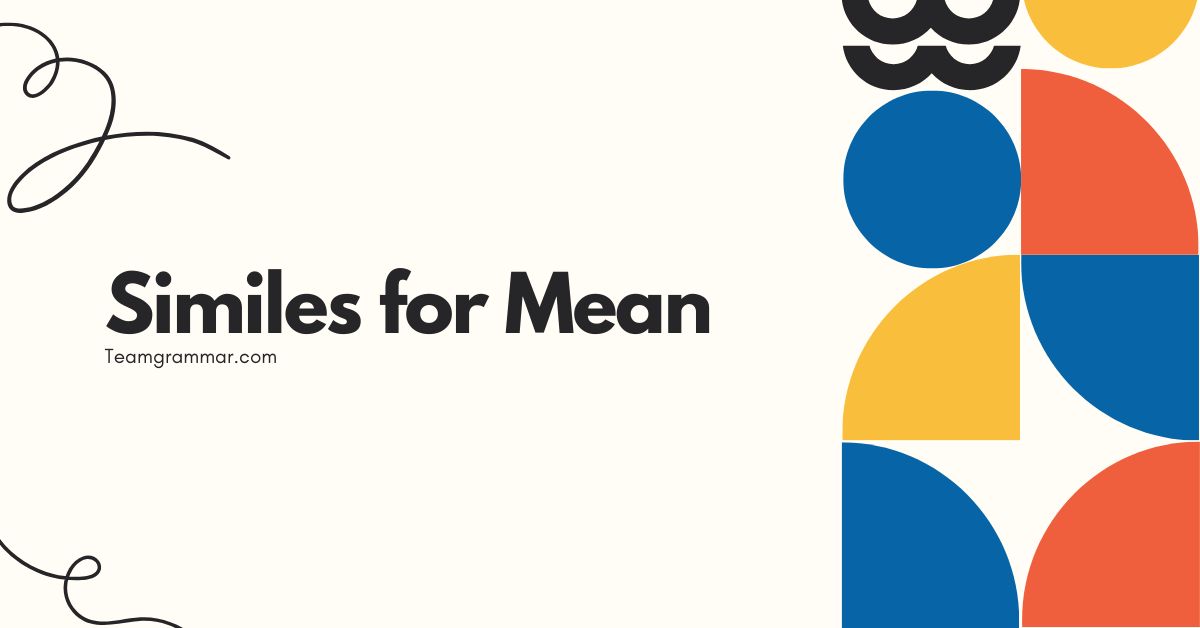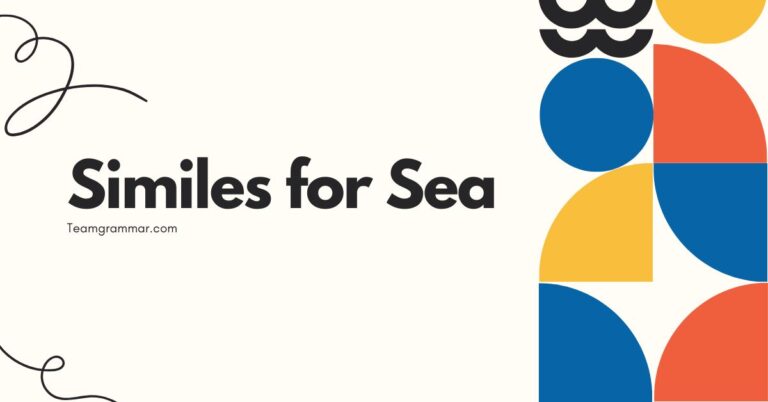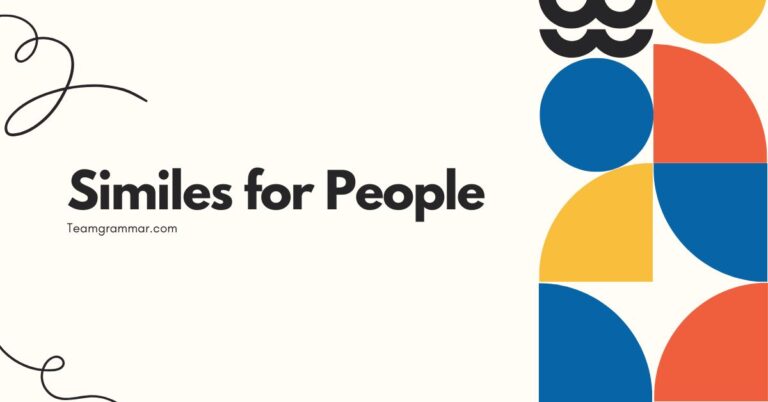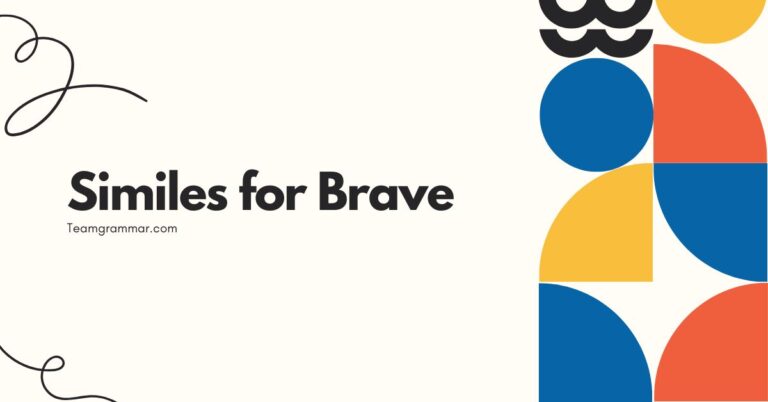41 Similes for Mean: Mastering Figurative Language
Understanding similes is crucial for enriching your English language skills. Similes, a type of figurative language, allow us to create vivid comparisons between seemingly unrelated things, adding depth and color to our descriptions.
This article focuses on similes specifically used to describe “mean” behavior or a “mean” personality, helping you articulate nuances of character and actions more effectively. Whether you’re an English language learner, a creative writer, or simply someone looking to enhance their communication skills, this guide will provide you with a comprehensive understanding of similes for “mean,” along with practical examples and exercises to solidify your knowledge.
Table of Contents
- Definition of Simile
- Structural Breakdown of Similes
- Types of Similes for “Mean”
- Examples of Similes for “Mean”
- Usage Rules for Similes
- Common Mistakes When Using Similes
- Practice Exercises
- Advanced Topics in Similes
- Frequently Asked Questions
- Conclusion
Definition of Simile
A simile is a figure of speech that compares two different things using the words “like” or “as.” Its primary function is to create a vivid image or to emphasize a particular quality by drawing a parallel between the subject and something else that shares that quality. Similes are fundamental to descriptive writing and are used extensively in literature, poetry, and everyday conversation to make language more engaging and expressive.
Unlike metaphors, which directly equate two things, similes acknowledge the comparison by using “like” or “as,” making the comparison more explicit.
In the context of describing someone who is “mean,” similes help us go beyond the simple adjective and paint a more detailed picture of their behavior or personality. They allow us to convey the specific type of meanness we’re observing, whether it’s cruelty, selfishness, or a general unpleasantness.
By comparing the mean person to something else that embodies that quality, we can create a stronger and more impactful impression on the listener or reader.
Structural Breakdown of Similes
The basic structure of a simile consists of three key components: thesubject(the thing being described), thelinking word(“like” or “as”), and thecomparison(the thing the subject is being compared to). Understanding this structure is crucial for creating effective and grammatically correct similes.
The subject is the person or thing whose meanness we are trying to describe. The linking word establishes the comparison.
The comparison provides the vivid image or quality that helps us understand the subject’s meanness.
For example, in the simile “He was as cruel as a viper,” “He” is the subject, “as” is the linking word, and “a viper” is the comparison. This structure allows for a clear and concise comparison, emphasizing the subject’s cruelty by associating him with the venomous nature of a viper.
The choice of the comparison is critical to the effectiveness of the simile. It should be something that the audience readily understands and associates with the quality being described.
The order of elements can sometimes be varied for stylistic effect, but the core components remain the same. For instance, you could say, “As cold as ice, his heart remained unmoved.” Here, the comparison (“as cold as ice”) comes first, but the subject (“his heart”) is still clearly identified.
While this variation can add emphasis or create a more poetic feel, it’s important to ensure that the comparison remains clear and unambiguous.
Types of Similes for “Mean”
The concept of “mean” encompasses a range of behaviors and personality traits. Therefore, similes used to describe meanness can be categorized based on the specific type of meanness they convey.
Here, we’ll explore several types of similes that capture different facets of a mean person.
Similes Describing Cruelty
These similes emphasize the deliberate infliction of pain or suffering. They often involve comparisons to predators, torturers, or other entities associated with causing harm.
Similes Describing Unpleasantness
These similes focus on the general disagreeableness or offensiveness of a person’s demeanor. They may involve comparisons to foul odors, irritating sounds, or other unpleasant experiences.
Similes Describing Selfishness
These similes highlight the person’s excessive concern for their own needs and desires, often at the expense of others. They might involve comparisons to hoarders, gluttons, or others who prioritize self-interest.
Similes Describing Cold-Heartedness
These similes emphasize the lack of empathy or compassion. They frequently use comparisons to ice, stone, or other things that are devoid of warmth and feeling.
Similes Describing Vindictiveness
These similes focus on the person’s desire for revenge or retribution. They may involve comparisons to those who hold grudges, seek vengeance, or are unwilling to forgive.
Examples of Similes for “Mean”
To illustrate the different types of similes for “mean,” here are several examples organized by category. Each example is designed to provide a clear and vivid depiction of the specific type of meanness being described.
Similes Describing Cruel Behavior
Cruel behavior involves the intentional infliction of pain or suffering. These similes often compare the mean person to predators or instruments of torture.
The table below showcases a variety of similes that effectively capture the essence of cruel behavior, providing vivid comparisons to enhance understanding.
| Simile | Explanation |
|---|---|
| As cruel as a viper | Implies a venomous and deadly form of cruelty. |
| As ruthless as a dictator | Conveys a sense of absolute power and disregard for others’ well-being. |
| As heartless as a stone | Suggests a complete lack of empathy or compassion. |
| As vicious as a wild dog | Emphasizes the uncontrolled and savage nature of the cruelty. |
| As merciless as a firing squad | Highlights the lack of pity or forgiveness. |
| As brutal as a storm | Compares the cruelty to a destructive and overwhelming force. |
| As cold as a winter wind | Suggests an emotional chill and a lack of warmth. |
| As sharp as a razor | Implies a cutting and painful form of cruelty. |
| As unforgiving as the desert | Conveys a sense of harshness and lack of leniency. |
| As predatory as a hawk | Highlights the exploitative and opportunistic nature of the cruelty. |
| As sadistic as a torturer | Directly compares the person to someone who enjoys inflicting pain. |
| As inhumane as a machine | Suggests a lack of human feeling or consideration. |
| As crushing as a vise | Emphasizes the overwhelming and suffocating nature of the cruelty. |
| As poisonous as hemlock | Implies a toxic and destructive form of cruelty. |
| As savage as a barbarian horde | Conveys a sense of unrestrained and violent cruelty. |
| As piercing as an icicle | Suggests a sharp and penetrating form of cruelty. |
| As bitter as gall | Implies a deeply resentful and unpleasant form of cruelty. |
| As devoid of feeling as a robot | Highlights the complete absence of empathy or emotion. |
| As destructive as termites | Compares the cruelty to a slow but pervasive force of destruction. |
| As harsh as a drill sergeant | Suggests a strict and unforgiving form of cruelty. |
| As abrasive as sandpaper | Implies a grating and irritating form of cruelty. |
| As cutting as a surgeon’s knife | Highlights the precise and intentional nature of the cruelty. |
| As isolating as solitary confinement | Emphasizes the loneliness and despair caused by the cruelty. |
| As devastating as a wildfire | Compares the cruelty to a widespread and destructive force. |
Similes Describing Unpleasant Demeanor
Unpleasant demeanor refers to a generally disagreeable or offensive manner. These similes often compare the mean person to things that are annoying, irritating, or simply unpleasant.
The following table provides a range of similes designed to vividly illustrate unpleasant behavior, offering diverse and impactful comparisons.
| Simile | Explanation |
|---|---|
| As irritating as nails on a chalkboard | Conveys a sense of grating and highly annoying behavior. |
| As sour as a lemon | Suggests a bitter and disagreeable personality. |
| As obnoxious as a loudmouth | Highlights the person’s offensiveness and lack of consideration. |
| As grating as a rusty hinge | Implies an irritating and unpleasant quality. |
| As unwelcome as a skunk at a picnic | Emphasizes the person’s unwanted presence. |
| As offensive as rotten eggs | Suggests a highly disagreeable and repulsive nature. |
| As annoying as a mosquito | Highlights the person’s persistent and bothersome behavior. |
| As prickly as a cactus | Conveys a sense of defensiveness and unapproachability. |
| As disagreeable as a spoiled child | Implies a petulant and unpleasant demeanor. |
| As tiresome as a broken record | Highlights the person’s repetitive and boring behavior. |
| As bothersome as a fly buzzing around | Suggests a persistent and irritating presence. |
| As grating as static on the radio | Implies an irritating and disruptive quality. |
| As unpleasant as a root canal | Emphasizes the highly undesirable nature of the experience. |
| As unwelcome as rain on your wedding day | Highlights the person’s inopportune and unwanted presence. |
| As irritating as a dripping faucet | Conveys a sense of persistent and annoying behavior. |
| As abrasive as steel wool | Implies a harsh and irritating quality. |
| As revolting as spoiled milk | Suggests a highly disagreeable and repulsive nature. |
| As distracting as a flickering light | Highlights the person’s ability to disrupt and annoy. |
| As unwanted as a virus | Emphasizes the person’s unwelcome and harmful presence. |
| As bothersome as a telemarketer | Suggests a persistent and intrusive presence. |
| As disagreeable as a bad smell | Implies an offensive and unpleasant quality. |
| As irritating as a pebble in your shoe | Highlights the person’s ability to cause persistent discomfort. |
| As unsettling as a spider crawling on you | Emphasizes the person’s ability to make others feel uneasy. |
Similes Describing Selfish Actions
Selfish actions are characterized by an excessive concern for one’s own needs and desires, often at the expense of others. These similes often compare the mean person to hoarders, gluttons, or others who prioritize self-interest.
The following table explores similes that effectively depict selfish behavior, offering diverse and insightful comparisons to enhance comprehension.
| Simile | Explanation |
|---|---|
| As greedy as a pig | Conveys a sense of insatiable desire and self-indulgence. |
| As selfish as a miser | Highlights the person’s unwillingness to share or give. |
| As possessive as a dragon guarding its hoard | Emphasizes the person’s unwillingness to let go of what they have. |
| As self-centered as a black hole | Suggests that everything revolves around the person and their needs. |
| As avaricious as a loan shark | Highlights the person’s excessive desire for wealth and profit. |
| As acquisitive as a collector | Conveys a sense of wanting to accumulate everything for themselves. |
| As self-serving as a politician | Implies that the person is only interested in their own gain. |
| As grasping as a climbing vine | Highlights the person’s tendency to take advantage of others. |
| As egocentric as a narcissist | Suggests an excessive admiration of oneself. |
| As inconsiderate as a bulldozer | Highlights the person’s disregard for others’ feelings and needs. |
| As preoccupied with themselves as a cat grooming | Conveys the idea that they are constantly focused on their own image and needs. |
| As stingy as Scrooge | Highlights the person’s extreme unwillingness to spend or share money. |
| As demanding as a spoiled brat | Implies that the person expects to get whatever they want, regardless of others. |
| As indifferent as a rock | Suggests a lack of concern or interest in other people’s problems. |
| As opportunistic as a vulture | Highlights the person’s tendency to exploit situations for their own benefit. |
| As wrapped up in themselves as a mummy | Conveys the idea that they are completely isolated and focused on their own world. |
| As consumed by greed as a gold digger | Implies that the person is primarily motivated by the pursuit of wealth. |
| As indifferent as a mannequin | Suggests a lack of emotional engagement and concern for others. |
Similes Describing Cold-Heartedness
Cold-heartedness refers to a lack of empathy or compassion. These similes often compare the mean person to ice, stone, or other things that are devoid of warmth and feeling.
The table below presents a selection of similes designed to effectively capture the essence of cold-hearted behavior, providing vivid comparisons to enhance understanding.
| Simile | Explanation |
|---|---|
| As cold as ice | Conveys a sense of emotional detachment and lack of warmth. |
| As heartless as a machine | Highlights the person’s lack of human feeling or compassion. |
| As unfeeling as a stone | Suggests a complete absence of empathy or emotion. |
| As distant as a star | Implies a remote and unapproachable demeanor. |
| As emotionless as a robot | Highlights the person’s lack of emotional expression. |
| As frigid as a glacier | Conveys a sense of coldness and emotional distance. |
| As indifferent as a statue | Suggests a lack of concern or interest in others. |
| As detached as an observer | Implies a lack of emotional involvement or connection. |
| As unyielding as granite | Highlights the person’s inflexibility and lack of compassion. |
| As unmoved as a mountain | Suggests a lack of emotional response or empathy. |
| As aloof as a cat | Conveys a sense of emotional distance and independence. |
| As unresponsive as a wall | Highlights the person’s lack of emotional engagement. |
| As hardened as steel | Suggests a resilience and toughness, but also a lack of empathy. |
| As barren as a desert | Conveys a sense of emotional emptiness and lack of warmth. |
| As devoid of warmth as a morgue | Highlights the person’s lack of human connection and empathy. |
| As icy as a winter storm | Conveys a sense of coldness and emotional turbulence. |
| As uncompassionate as a judge | Implies a strict adherence to rules without regard for individual circumstances. |
| As indifferent as a spectator | Suggests a lack of active participation or emotional investment. |
Similes Describing Vindictive Behavior
Vindictive behavior is characterized by a desire for revenge or retribution. These similes often compare the mean person to those who hold grudges, seek vengeance, or are unwilling to forgive.
The following table explores similes that effectively depict vindictive behavior, offering varied and insightful comparisons to enhance comprehension.
| Simile | Explanation |
|---|---|
| As vengeful as a wronged spirit | Conveys a sense of relentless pursuit of retribution. |
| As unforgiving as a debt collector | Highlights the person’s unwillingness to let go of perceived wrongs. |
| As spiteful as a betrayed lover | Suggests a desire to inflict pain on those who have hurt them. |
| As bitter as a rejected suitor | Implies a deep resentment and desire for revenge. |
| As resentful as a forgotten child | Conveys a sense of long-held anger and bitterness. |
| As malicious as a gossipmonger | Highlights the person’s desire to harm others through words. |
| As vindictive as a scorned woman | Suggests a fierce determination to seek revenge. |
| As retaliatory as a cornered animal | Implies a defensive and aggressive response to perceived threats. |
| As relentless as a predator | Highlights the person’s determination to pursue their revenge. |
| As unforgiving as a computer | Suggests a lack of human empathy or understanding. |
| As consumed by revenge as a tragic hero | Conveys a sense of being driven by a single-minded desire for retribution. |
| As determined as a bloodhound | Highlights the person’s persistence in tracking down their target. |
| As fixated as a stalker | Implies an unhealthy obsession with seeking revenge. |
| As implacable as a judge | Suggests an unwillingness to be swayed by appeals for mercy. |
| As unforgiving as time | Highlights the inevitable consequences of one’s actions. |
| As driven by hate as a fanatic | Conveys a sense of being consumed by negative emotions. |
| As unforgiving as a jilted bride | Suggests a deep sense of betrayal and a desire for retribution. |
| As tenacious as a bulldog | Highlights the person’s refusal to give up on their quest for revenge. |
Usage Rules for Similes
Using similes effectively requires adherence to certain rules. First, ensure that the comparison is logical and understandable.
The two things being compared should share a common quality that is relevant to the description. Second, avoid clichés.
Overused similes like “as busy as a bee” or “as strong as an ox” can make your writing sound unoriginal and predictable. Instead, strive to create fresh and imaginative comparisons.
Third, maintain consistency in tone and style. The simile should fit seamlessly into the overall context of your writing.
Fourth, be mindful of cultural context. Some comparisons may not be universally understood or may carry unintended connotations in different cultures.
Consider your audience and choose comparisons that are appropriate and relevant. Fifth, ensure grammatical correctness.
The simile should be grammatically sound and easy to understand. Avoid awkward phrasing or ambiguous language.
Common Mistakes When Using Similes
One common mistake is using similes that are too obvious or cliché. For example, saying someone is “as mean as a snake” is not particularly original or insightful.
A better simile might be “as mean as a loan shark,” which provides a more specific and vivid image. Another mistake is using similes that are illogical or nonsensical.
For instance, saying someone is “as mean as a cloud” doesn’t make much sense because clouds are not typically associated with meanness. The comparison should be clear and relevant.
A third mistake is mixing metaphors and similes. It’s important to maintain consistency in your figurative language.
For example, don’t start with a simile (“as mean as a viper”) and then switch to a metaphor (“he was a walking plague”). This can create confusion and weaken the impact of your writing.
Table showcasing correct and incorrect examples:
| Incorrect | Correct |
|---|---|
| He was as mean as the weather. | He was as mean as a loan shark. |
| She was like a mean cloud. | She was as cold as ice. |
| He is a lion, as mean as can be. | He is as mean as a lion. |
Practice Exercises
Test your understanding of similes for “mean” with these practice exercises. Fill in the blanks with appropriate comparisons to complete the similes.
| Question | Answer |
|---|---|
| 1. He was as cruel as a __________. | viper |
| 2. She was as unpleasant as __________. | rotten eggs |
| 3. His selfish actions were as greedy as a __________. | pig |
| 4. Her cold heart was as frozen as __________. | ice |
| 5. He was as vindictive as a __________. | wronged spirit |
| 6. The bully was as mean as a __________. | drill sergeant |
| 7. Her words were as sharp and mean as a __________. | razor |
| 8. The boss was as selfish as __________. | Scrooge |
| 9. The villain was as ruthless as a __________. | dictator |
| 10. His heart was as hard and mean as __________. | stone |
Exercise 2: Rewrite the following sentences using similes for “mean.”
| Question | Answer |
|---|---|
| 1. He was very cruel to his brother. | He was as cruel as a viper to his brother. |
| 2. She was extremely unpleasant to be around. | She was as unpleasant as rotten eggs to be around. |
| 3. His actions were very selfish. | His actions were as greedy as a pig. |
| 4. She showed no empathy at all. | Her heart was as frozen as ice. |
| 5. He wanted to get revenge on everyone. | He was as vindictive as a wronged spirit. |
| 6. The bully was very mean. | The bully was as mean as a drill sergeant. |
| 7. Her words were very hurtful. | Her words were as sharp and mean as a razor. |
| 8. The boss only cared about himself. | The boss was as selfish as Scrooge. |
| 9. The villain showed no mercy. | The villain was as ruthless as a dictator. |
| 10. His heart was hard and unfeeling. | His heart was as hard and mean as stone. |
Advanced Topics in Similes
Advanced learners can explore more nuanced aspects of similes, such as using them to create complex metaphors or combining multiple similes to build a more detailed description. You can also experiment with unconventional comparisons to create a unique and memorable effect.
For example, instead of saying “as mean as a viper,” you could say “as mean as a paper cut,” which is unexpected but still conveys a sense of annoyance and irritation.
Another advanced technique is to use similes to create irony or satire. By comparing a mean person to something seemingly harmless or even positive, you can highlight the absurdity of their behavior.
For instance, you could say “as sweet as poison,” which is a contradictory simile that suggests a hidden danger.
Frequently Asked Questions
Here are some frequently asked questions about similes and their usage:
- What is the difference between a simile and a metaphor?
A simile compares two things using “like” or “as,” while a metaphor directly equates two things without using those words. For example, “He is as mean as a viper” is a simile, while “He is a viper” is a metaphor.
- Can a simile be a cliché?
Yes, overused similes like “as busy as a bee” or “as strong as an ox” are considered clichés and should be avoided in favor of more original comparisons.
- How do I create a good simile?
Choose a comparison that is logical, relevant, and vivid. Avoid clichés and strive for originality. Also, consider your audience and cultural context.
- What are the key elements of a simile?
The key elements are the subject (the thing being described), the linking word (“like” or “as”), and the comparison (the thing the subject is being compared to).
- Why are similes important in writing?
Similes add depth, color, and clarity to writing by creating vivid images and emphasizing particular qualities. They make language more engaging and expressive.
- Can I use similes in formal writing?
Yes, but use them sparingly and choose comparisons that are appropriate for the tone and style of your writing. Avoid overly informal or colloquial similes.
- Is it okay to combine multiple similes in one sentence?
Yes, but be careful not to overload the sentence with too many comparisons. Use multiple similes judiciously to create a more detailed and impactful description.
- How can I practice using similes?
Try rewriting sentences using similes, or challenge yourself to come up with original similes for different words or concepts. Read widely and pay attention to how other writers use similes.
- What if I can’t think of a good simile?
Don’t force it. Sometimes, a simple, direct description is better than a weak or awkward simile. You can also try brainstorming or using a thesaurus to find related words or concepts that might inspire a comparison.
- Are there any online tools that can help me with similes?
Yes, there are several online thesauruses and figurative language generators that can provide inspiration and suggestions for similes. However, be sure to use these tools as a starting point and not as a substitute for your own creativity and critical thinking.
Conclusion
Mastering the use of similes, particularly those that describe “mean” behavior, can significantly enhance your ability to communicate effectively and creatively. By understanding the structure, types, and usage rules of similes, you can add depth, color, and nuance to your writing and speech.
Remember to choose comparisons that are logical, original, and appropriate for your audience. Avoid clichés and be mindful of cultural context.
With practice and attention to detail, you can become proficient in using similes to express yourself with greater clarity and impact.
As you continue to develop your skills, don’t be afraid to experiment with unconventional comparisons and advanced techniques. The more you practice, the more natural and intuitive the use of similes will become.
Keep reading, keep writing, and keep exploring the power of figurative language to enrich your communication.







